Tanaka, U.1
|
Abstract Semi-arid West Africa, known as the _ahel, is one of the front lines of desertification. There are a vast distribution of sandy soils developed on ancient dunes and the foot slopes that biomass production is largely dependent on. Due to the potential fragility derived from the sandy texture, soil management practices significantly influence either degradation or conservation of upland field. One of the characteristics of sandy soils in the Sahel is the presence of thin layer(s), which is a few milimeters thick and consists of finer soil particles, in the profile and at the immediate surface of soil. Field observation revealed that the thin layer(s) in the soil profile has a self-protection mechanism against wind erosion. The thin layer formed at the surface of soil through tillage practice, known as a crust, accelerates water erosion. The case of Central Mali suggest that a mould-board plow, which is used for weeding, disrupted some thin layers and encouraged a crust formation at the soil surface. Although the plow is efficient for weeding, the management practice resulted in increased runoff and selective loss of finer soils which generate a vicious cycle of soil degradation. A hint to solve the problem was found in the case of Northeast Burkina Faso where management practices utilize a push-hoe. The push-hoe, a simple tool traditionally used for weeding, disturbed only a few centimetres of surface soil without disruption of the thin layers. Tools and the ways of soil management practices are influential in the conservation of the thin layers in soil and the prevention of crust formation at the surface, thus the degradation of the Sahelian sandy soils. |
Semi-arid West Africa, known as the Sahel, is one of the front lines of desertification. UNCCD (1994) clearly defined, desertification/land degradation is “human-induced”. Serious aspect of desertification in the Sahel are caused through daily activities, such as crop cultivation, that are undertake by local people to maintain basic needs and to improve livelihoods.
Among soil management practices, tillage is one of the most influential practices that changes the condition of the soil surface where erosion processes take place. This study, therefore, focuses on the behaviours of surface soil under different tillage practices. Morphological characteristics and functions of sandy upland soil in the Sahel are firstly explained in relation to the processes of soil degradation. Then, the significance of soil management practices on both degradation and conservation are discussed referring to the cases of the field studies in Mali and Burkina Faso.
Field observation and measurements
Soil profiles were described to identify the soil names. Movement of surface soil associated with a series of soil management practices and rainfall events was observed in the field. The temporal changes of the soil surface undulation after tillage were measured by a line-measuring method (Tanaka, 1996). Details of local husbandry systems, e.g. cropping and livestock keeping, were described through the interview from farmers and field observation. By blowing air onto the soil surface under different condition, movement of sand grains was observed in order to assess the susceptibility to wind erosion. Degree of water erosion was assessed by measuring the height between the current level of land surface and the former level which was remained at the electric poles installed 20 years ago.
Laboratory analyses and micro-morphological observation
General soil properties, e.g. pH, texture, CEC, T-C, T-N _nd T-P, were measured in the laboratory. Undisturbed soils were collected from the soil surface and the profile, and thin section specimens prepared using the procedures described by Tanaka et al. (1992). To assess the effect of thin layer of finer particles on water permeability, clay suspension was added to the sand bed in a grass column filled with water and, then, the rate of water discharge from the column was measured (Tanaka, 1996).
General aspects of the study areas
Sahel streches over a vast area from the Atlantic coast of West Africa to Northeast Africa. With annual rainfall ranging between 250 and 500 mm, there are several local husbandries including crop cultivation and pastoralism under diverse agro-ecologcal condition. The rainy season is four months which is basically affordable to maintain crop/grass production, though the Sahel is frequently hit by drought/flooding due to irregular rainfall distribution. From satelite imagery, bands of ancient dunes can be identified extending east to west with some 10 km to 100 km long which overlaps with major places of crop/grass production (Tanaka et al., 2005). Table 1 shows the descriptive characteristics of the study sites in Mali and Burkina Faso. The soil of the site in Mali is classified as Typic Kandiustalfs (pHw: 5.0-5.5, Sand: 80-95%, CEC: 1.5-6.2 cmol/kg, T-C: 0.7-1.7 g/kg, and T-N: 0.03-0.14 g/kg) and that in Burkina Faso as Typic Quartzipsamments (pHw: 5.0-6.3, Sand: 90-95%, CEC: 1.0-3.0 cmol/kg, T-C: 0.4-1.3 g/kg, and T-N: 0.05-0.16 g/kg) referring to Soil Survey Staff (1996).
Table 1. Descriptive characteristics of the study site
|
Features/Site |
Thiongoni (Mali) |
Takabangou (Burkina Faso) |
|
Agro-ecological zone1 |
Transition Sudan – Sahel |
Sahel zone |
|
Annual rainfall |
550 mm | 400 mm |
| Wet years | 600~650 mm | 450~500 mm |
| Dry years | 400~450 mm | 300~350 mm |
| Landscape |
upland plain (<2%) |
ancient dune |
|
Management practices |
Sudan type2 |
Sahel type2 |
| Farming tool | hoe, plow | push-hoe |
|
Soil disturbance |
over-turning (15 cm) |
scratching (3-5 cm) |
|
Fertility recovery |
glass fallow, parcage3 |
glass fallow, parcage3 |
|
Habitants (ethnic) |
Bambara and Fulbe |
Songai, Fulbe and Bela |
1 Classified referring to Nicholson (1980). 2 Sudan type associates soil disturbance in weeding and Sahel type is basically no-tillage system (Ohji, 1990). 3 Parcage is French term referring to a patch of land in cultivated field where cattle herds are kept and feces are dropped during dry season.
Remarkable micro-morphological characteristics
In the Sahelian sandy soils, two types of remarkable micro-morphological structure can be identified, i.e. thin layer(s) and crust(s) of finer soil particles respectively found in the profile and at the surface of soil. These thin structures have different functions in terms of prevention/acceleration of desertification processes.
Thin layer(s) in soil profile: The key characteristic in the Sahelian sandy soil is the presence of thin layer(s), which is a few milimeters thick and consists of finer soil particles, found in the soil profile (Figure 1).
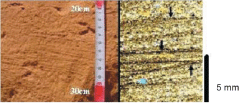
Figure 1. Micro-morphology of the soil profile in the study site, Burkina Faso (left: close-up of the profile, right: thin layers indicated in arrows)
Surface soil is usually disturbed and loosened through tillage activities and tramping by animals and people. Some loosen soils are removed by wind during dry season and the one of the thin layers is exposed to the surface. Field observation revealed that the soil was not removed by blowing air to the surface of the exposed thin layer. Once the thin layer was scratched, however, soil was removed until the next thin layer appeared. This emprical finding suggests that the thin layers in the profile of sandy soil inherently has a mechanism of self-protection against wind erosion.
Crust formation at the soil surface: Field observation revealed that particles of sandy soil were tend to be easily seggregated when they moved under the impact of raindrops and runoff water. It was also observed that the seggregated finer soil particles were sedimented and fromed a thin layer (crust) at the immediate surface of soil as shown in Figure 2.
Soil management practices and its influences
Case studies in Mali and Burkina Faso revealed that a type of farming tool has an influential impact on accerelation or slowing-down of soil erosion.
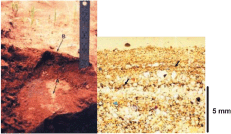
Figure 2. Micro-morphology of the soil profile in the study site, Mali (left: surface of the ridge where a crust was formed, right: crusts, indicated in arrows, found at the immediate surface of the ridge)
A case in Thiongoni Village, Central Mali: Mould-board plow is widely used for weeding in rain-fed millet cultivation. The plowing is repeated three times, once for ridge-making and twice for weeding, during the cropping season. In plowing, the soil was disturbed to a depth of 15 cm and the thin layers were observed to be broken. In addition, ridges were also formed with exposed subsurface soil, which relatively rich in finer particles, to the surface. When the ridge collapsed under rainfall, a crust was formed in the immediate surface of soil as shown in Figure 2. Figure 2 shows a patterns of combined thin layers of finer and coarser particles, and this micro-morphological feature is evidence that some soils moved with runoff water from the ridge to the inter-ridge space. The measurement of temporal changes of the surface unduration also suggested that the ridge soil collapsed and moved with runoff water. A laboratory experiment demonstrated that an additon of approximately 10 mg/cm2 of clay, wh_ch was a small portion of clay contained in the removed soil, decreased the initial water permeablilty of 7.2 mm/min to less than 0.1 mm/min, suggeting the increase of water runoff.
Figure 3 shows the selective loss of finer particles from the surface soil. More than 60% of the finer particles were selectively removed from the top 4 cm.
These processes, which is initiated by the use of a mould-board plow, are repeated every year. Although no direct evidence was found between these proceses and soil erosion, the field measurement estimated that the rate of soil loss in the study site ranged between 5.1 and 19.5 mm/year. The mould-board plow, originally used for cotton cultivation in Sudan savanna zone, is effective and efficient for weeding in cultivated field of heavy texture soil. Due to the merits, the use of the tool is recommended by government authority and widely accepted by cultivators, unfortunately even in the Sahel, despite of potential risk to accerelate soil erosion as suggested in the case study.
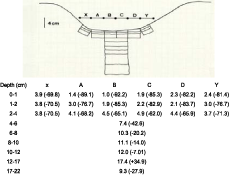
Figure 3. Selective loss of finer particles estimated from the particle size distribution in the inter-ridge soil. (the value is the % of silt + clay; the value in parentheses is the % of lost silt + clay from the original soil)
A case in Takabangou Village, Northeastern Burkina Faso: Contrarily, minimum tillage using a traditional push-hoe is commonly practiced in the vast area of the Sahel for weeding. Disturbance of soil is limited to a few centimetres of the surface, and most of the thin layers in the soil profile are conserved intact. The traditional tillage with this simple tool is, thus, well suited under the Sahelian condition to minimize the soil loss by wind erosion, although there are some disadvantages, i.e. low efficiency and heavy work-load. Improvement of the soil-friendly tool will be one of the next study issues.
Micro-morphological study revealed that there are thin layers consist of finer particles in the profile of the Sahelian sandy soil. Simple field examination and observation suggested that the thin layer has an inherent role of self-protection against wind erosion. The traditional tillage practice for weeding with a push-hoe minimizes the disruption of the thin layers. Contrasting this, tillage with a mould-board plow disrupts the thin layers and makes ridges at the soil surface. Field and micro-morphological observation revealed that movement of soil from the ridge with water under rainfall event encourages the formation of crust in the immediate surface of soil, leading to a drastic decrease of water permeability, runoff water and selective loss of finer soil particles.
This comparative study showed that selection of tools and the associated tillage practices have great influences on the conservation and/or disruption of the thin layers in the soil profile and the formation of crust in the soil surface, thus, the degradation and/or conservation of upland sandy soils in the Sahel.
Nicholson, S.E. 1980. The nature of rainfall fluctuations in subtropical West Africa. Mon Weather Rev., 180: 473-487.
Ohji, T. 1990. Les techniques de culture du mil au Mali: types et distribution. In Boucle du Niger – approches multidisciplinaires, (ed. Kawada J.), 2: 1-62, Institut de Recherches sur les Langues et Cultures d’Asie et d’Afrique, Tokyo (in French).
Soil Survey Staff. 1996. Keys to soil taxonomy, 7th ed., USDA, pp. 644, Washington.
Tanaka, U., Yokoi, Y., and Kyuma, K. 1992. Morphological characteristics of soil surface crusts formed under simulated rainfall. Soil Sci. Plant Nutr., 38(4), 655-664.
Tanaka, U. 1996. Soil surface management under conventional farming system with reference to soil degradation – case study in Mali and Northwestern India. So_l Phys. Cond. Plant Growth, Jpn., 74: 51-57 (in Japanese with English summary).
Tanaka, U., Seto, S., Shinjo, H., and Miyazaki, H. 2005. Realities and problems of external commitment as viewed from desertification study at a life-size scale. In Proceeding of J-FARD & JIRCAS International Symposium on Perspectives of R&D for improving agricultural productivity in Africa, July 14-15, United Nations University, 38-41, J-FARD & JIRCAS, Tokyo.
UNCCD. 1994. Elaboration of an International Convention to Combat Desertification in Countries experiencing Serious Drought and/or Desertification, particularly in Africa. Geneva, 21-31 March.
Golabi, M.H.1; P. Denney1 and C. Iyekar1
|
Abstract One of the major problems of agricultural soils in tropical regions of the Pacific is the low organic matter content. Composted organic material is applied to agricultural fields as an amendment to provide nutrients and also to enhance the organic matter content and improve the physical and chemical properties of the cultivated soils. Land application of composted material as a fertilizer source not only provides essential nutrients to plants, it also improves soil quality and effectively disposes of wastes. In our soil program at the University of Guam, we are evaluating the use of organic material as an alternative to synthetic fertilizers. Our goal is to develop management strategies and use available resources for improving crop productivity while conserving resources and preserving environmental quality. Our case study project is designed to improve soil fertility status by using composted organic wastes and assessing how nitrogen and other essential nutrients contribute to long-term soil fertility and crop productivity without application of inorganic fertilizers. In our pilot project compost is produced from milled typhoon debris mixed with animal manure, fish meal, shredded paper and other organic wastes. Mature compost is then applied to the field at rates of 0, 5, 10, 15, and 20 t ha -1 as a soil amendment on an eroded Cobbly soil of Southern Guam. Corn was planted and monitored for growth performance and yield. The effect of land application of composted material on the soil organic matter (SOM) content and other properties as the soil quality indices are being evaluated in this pilot study. |
Now more than ever the importance of an adequate supply of plant nutrients to ensure efficient crop production is being recognized. Growers are continually striving to overcome nutrient deficiencies and adopt improved management practices in order to increase yields for more profit. Great progress in fertilizer technology and the use of plant nutrients has been made in recent years, and a wider understanding of plant and soil chemistry has led to improved fertilization and farming practices that have improved crop yields worldwide (Tisdale et al., 1985). However, over-application of commercial fertilizers may reduce farm profits, create a risk of soil degradation, and cause environmental pollution (Tisdale et al., 1985). The ease of applying synthetic fertilizers and the lack of knowledge for matching fertilizer applications to the nutrient requirements of certain crops have added to the problem.
Among the problems _nherent to tropical soils, soil acidity, characterized by low pH, excessive aluminum, deficient calcium, and low organic matter are the most serious (Hue, 1992). Tropical soils are often unproductive because some of these soils are prone to strong phosphate fixation that renders phosphorus unavailable to plants. Soils that are prone to such phosphate fixation (adsorption of P to oxides and clay minerals) often require extremely high phosphate fertilizer applications in order to alleviate the effect of phosphate fixation. Selvi et al. (2003) reported that the application of rock phosphate with organic manure enhances the dissolution of rock phosphate in the soil and thus increases the plant availability of P. As referred to by Selvi et al. (2003), Bagavathiammal and Mahimairaja (1999) reported that the organic acids produced during the decomposition of organic manure supply protons for rock phosphate dissolution.
Soil acidity and mineral deficiencies can be corrected by lime and fertilizers but, these are not always viable options for small or resource-poor farmers (Hue, 1992). However, Hue (1992) reported that green manures and composted organic material increase soil organic matter and provide plant nutrients, alleviate aluminum toxicity, and render phosphorus more available to crops. This increased availability of phosphorus is believed to be the result of the reaction of organic matter-derived molecules with soil minerals (Hue, 1992).
In the hot and humid tropical environment, weathering of soils is rapid; thus, large areas of Ultisols and Oxisols occur in these regions (Motavalli, 1997). Thus the inherent poor chemical properties of Ultisols and Oxisols pose problems for agriculture in these regions. The fertility of these soils is often limited by properties that evolve from high iron and aluminum content, low activity clay, and low organic-matter content. These limitations are often manifested by the following properties:
In humid tropical climates, the loss of basic cations and the related acidity and aluminum toxicity require special management techniques. Heavy rainfall and high temperatures in these regions also promote rapid organic matter decomposition, which may also release H+ ions that acidify the soil and increase exchangeable Al to toxic levels that limit root growth in the subsoil.
One of the most important nutrients limiting crop yield in the tropics is nitrogen (N). The concentration of native available N in tropical soils fluctuates considerably in response to seasonal changes (Sanches, 1976). Fertilizer recommendations, cropping calendar and the farming system therefore need to take into account the seasonal availability of N. Nyamangara et al. (2003) reported that nitrogen uptake from the organic waste material (animal manure) was greater in the second season compared with the first season. This implied that the N from the organic fertilizer became more available (through mineralization) for plant uptake in the second year compared with first year (Nyamangara, et al., 2003). In addition to nutrient value, the application of aerobically composted organic waste (manure) to soil does not pose an environmental concern regarding NO3-leaching presumably due to the high degree of stabilization that occurs during the decomposition of the organic waste (Nyamangara et al., 2003). Nyamangara et al. (2003) reported that the organic waste (composted manure) application actually enhanced the use efficiency of mineral N fertilizer by crops when the two were applied in combination.
In the hot and humid environment of tropical regions in the Pacific the soil organic matter is minimal due to rapid decomposition. In addition to its slow release nutrient capability, organic matter is largely responsible for aggregation, soil moisture holding capacity and other improved physical properties of the soil. Thus, increasing soil organic matter content must be the first step in any farming practice in the Pacific region. Fuller (1951) stated that the continued productivity of the soils depends largely upon the replenishment and maintenance of the soil organic constituents. Organic matter additions are the only means of making some soils economically productive (Cook and Ellis, 1987). Well-decomposed organic matter has a very high cation-exchange capacity that adds to the buffer capacity of the soil. Hence, an adequate supply of soil organic matter makes it safe to apply rather large applications of fertilizer at planting time and thus avoid the need for a second application (Cook and Ellis, 1987).
Among the practices recommended for improvement of the soil quality and soil fertility in tropical regions is the application of composted organic wastes, which slowly release significant amounts of nitrogen and phosphorus (Muse, 1993; Zibilske, 1987; Eghball, 2001). In addition to supplying plant nutrients, organic compost has been shown to increase soil organic matter, enhance root development, improve germination rates and increase water-holding capacity of soils (Muse, 1993; Zibilske, 1987). Application of organic material promotes biological activity, enhances nutrient exchange capacity, improves water balance, increases organic matter content and improves the structure of the soil (Muse, 1993; Zibilske, 1987).
In our soil program at the University of Guam, we are evaluating the use of composted organic material as an alternative to synthetic fertilizers to increase yield and enhance crop productivity. More specifically, we are studying the effect of organic matter and inorganic soil constituents in order to improve soil quality for agricultural sustainability. Our goal is to develop management strategies and use available resources to increase soil organic matter for improving crop production while conserving natural resources and preserving environmental quality. Our case study project is therefore, designed to improve soil fertility status by using composted organic wastes as soil amendment and assessing how the nitrogen and other essential nutrients contribute to long-term soil fertility and crop productivity without application of synthetic fertilizers.
Composting of readily available materials was undertaken at the Inarajan Agricultural Experiment Station in the district of Inarajan Village in Southern Guam. In our case study at the research station of the University of Guam, tree trimmings from the roadsides, chicken, hog and horse manure from local farmers and ranchers and wood chips from typhoon debris were used for compost production.
Passively treated compost piles were supplied with air through perforated pipes embedded in the pile, with occasional mixing of the compost using a backhoe. Samples were collected from different sections of the compost pile for nutrient characterization before the compost was applied on the treatment plots. Seven samples were collected randomly and were mixed to produce one composite sample and brought to the lab for analysis. Total Kjeldahl nitrogen (Page et al., 1982) and NO3 by Lachate was determined. Soluble phosphorus was determined colorimetrically by using sodium bicarbonate (Olsen and Sommers, 1982). The pH was determined in a 1:5 soil:water paste using a combination electrode.
In the second stage of the experiment we applied the composted organic material to plots as a source of fertilizer in order to evaluate the agronomic value of the organic compost on crop production. In addition, the effect of compost as s_il amendment for enhancing soil quality and improving soil properties was evaluated.
Twelve field plots (7.6 × 5.5 m2) were set up at the Inarajan experiment station in Southern Guam for this project. The soil under study is the Akina series (Very fine, kaolinitic, isohypothermic Oxic Haplustalf) formed on residuum derived from the volcanic deposit (USDA-SCS, 1988). Composted organic wastes were applied 0 (control), 5, 10, 15, and 20 t ha-1 and each rate were replicated three times.
The compost characteristics and range of compositional values for each time before the land application of the organic material are presented in Table 1. As shown in Table 1, the carbon to nitrogen ratio of the compost before land application ranged from 37 to 47 over the two sampling periods. The compost was incorporated 10 cm into the soil one week before the corn was planted in order to allow the carbon to nitrogen ratio to stabilize itself during this period. Vigorous growth during the growing season reflected sufficient nitrogen release by the compost indicating that the initial high carbon to nitrogen ratio did not suppress plant growth.
The results indicated that under the unique climatic conditions of Guam, land application of organic compost enhanced soil quality and increased soil fertility considerably. As shown in Tables 2, 3, and 4 considerable improvements in bulk density, soil organic matter content, soil pH, nutrient distribution, and other soil quality parameters occurred with the increased application of composted organic material on the soil under treatment.
Table 1. Some of the characteristics of compost at the time of application
|
Compost Application Phase |
pH |
Moisture Content (%) |
Carbon Content (%) |
Total N (%) |
C/N Ratio |
Nitrate (NO3) (mg kg-1) |
Phosphate (PO4) |
Potassium (K) |
Calcium (Ca) |
Magnesium (Mg) |
|
Nov. 2003 April 2004 |
7.27 7.48 |
49.6 |
25.1 |
0.672 0.618 |
37.4 47.7 |
231.5 173.8 |
162.70 151.94 |
5,362.1 4,761.2 |
3,672.3 5,612.4 |
1,174.6 9,840.4 |
Table 2. Measured soil parameters after different rates of compost application – April/May 2003
|
Compost Application Rate |
Bulk Density (gm/cm3) |
Moisture Content (%) |
Organic Matter (%) |
Nitrate (NO3) |
Phosphate (PO4) |
Potassium (K) |
Calcium (Ca) |
Magnesium (Mg) |
CEC (meq/ 100 g soil) |
|
| 0 t/ha | 8.0 | 1.18 | 26.01 | 5.36 | 32.8 | 30.09 | 206.83 | 3,416.17 | 171.40 |
1.90 |
| 5 t/ha | 7.6 | 1.01 | 25.86 | 5.64 | 49.6 | 52.34 | 744.97 | 3,779.88 | 297.59 |
2.33 |
| 10 t/ha | 7.6 | 0.98 | 28.07 | 6.57 | 58.9 | 61.02 | 1,053.36 | 4,748.70 | 431.20 |
2.98 |
| 20 t/ha | 7.7 | 0.91 | 32.16 | 9.46 | 160.1 | 76.65 | 1,418.71 | 5,492.18 | 787.92 |
3.77 |
Table 3. Measured soil parameters after different rates of compost application – Nov./Dec. 2003
|
Compost Application Rate |
Bulk Density (gm/cm3) |
Moisture Content (%) |
Organic Matter (%) |
Nitrate (NO3) |
Phosphate (PO4) |
Potassium (K) |
Calcium (Ca) |
Magnesium (Mg) |
CEC (meq/ 100 g soil) |
|
| 0 t/ha | 7.9 | 1.03 |
37.59 |
3.43 |
13.3 |
17.82 |
217.03 |
3,178.61 |
182.63 |
2.17 |
| 5 t/ha | 7.8 | 0.98 |
37.70 |
4.56 |
41.8 |
35.83 |
485.40 |
3,300.61 |
337.88 |
2.62 |
| 10 t/ha | 7.8 | 1.03 |
40.54 |
5.43 |
57.6 |
44.63 |
748.54 |
3,495.12 |
511.26 |
3.24 |
| 20 t/ha | 7.6 | 1.01 |
44.60 |
7.18 |
79.3 |
58.43 |
1,064.72 |
4,312.43 |
807.02 |
4.16 |
Table 4. Measured soil parameters after different rates of compost application – April/May 2004
|
Compost Application Rate |
Bulk Density (gm/cm3) |
Moisture Content (%) |
Organic Matter (%) |
Nitrate (NO3) |
Phosphate (PO4) |
Potassium e(K) |
Calcium (Ca) |
Magnesium (Mg) |
CEC (meq/ 100 g soil) |
|
| 0 t/ha | 8.2 | 1.16 | 34.11 | 2.78 | 9.8 |
18.93 |
390.41 |
3,694.64 |
172.66 |
2.09 |
| 5 t/ha | 8.0 | 1.04 | 39.18 | 5.52 | 16.6 |
42.43 |
859.30 |
4,875.00 |
375.42 |
2.97 |
| 10 t/ha | 7.9 | 1.02 | 44.64 | 7.40 | 22.9 |
57.68 |
1,265.00 |
5,608.87 |
601.48 |
3.63 |
| 15 t/ha | 7.6 | 0.99 | 42.77 | 10.30 | 88.0 |
64.69 |
1,950.20 |
5,835.57 |
849.49 |
4.12 |
Data obtained from the first trial indicated that as the compost application rates were increased from 0 (control) to 5, 10 and 20 t ha-1, the soil CEC (cation exchange capacity), one of the major soil quality indexes, was also increased, indicating a considerable improvement in nutrient exchange capacity of the soils treated with organic matter amendments (Table 2, 3, 4). A significant yield increase (Figure 1A, 1B, 1C) in plots with compost application of 10 and 20 tonnes per hectare provides evidence of these improvements.
Following the first harvest in May 2003, the plots were re-planted during the wet season (August to December) of 2003. The same soil quality enhancement occurred following the second round of the compost application on the treated soils (Table 3). Yield results from the dry season trial showed an even higher increase in crop yield as the compost application rate was increased from 0 (control) to 5, 10, and 20 t ha-1 (Figure 1). It should be noted that the yield results from the second trial reflect the effect of previous compost application on these plots. In addition to yield increase, the quality of the corn crop also improved as a result of the increasing compost application rate (Figure 2). Data from the second corn harvest (December of 2003), however, showed that the yield increase from 10 t ha-1 was not significantly different from the 20 t ha-1 (Figure 1) indicating that the highest rate of compost application only promotes vegetative growth (Figure 3) at the expense of grain production. Therefore, the application rate from 20 tonnes per hectare was adjusted to 15 tonnes per hectare on the third trial for the same crop (Figure 1C). The results from the third trial were then used to establish an optimum level of the compost application rate, which can then be recommended to the local farmers who are currently using organic material as the source of soil nutrient for their crops.
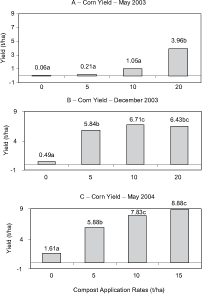
Figure 1. Yield results showing gradual increase as compost application rates were increased [*Mean shown on the columns followed by the same letter are not significantly different according to Fisher’s LSD multiple comparison test (P <0.05)]
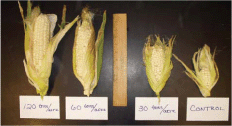
Figure 2. Showing that in addition to yield increase, quality of corn crop was also improved as the result of increased compost application rate
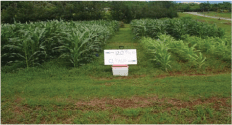
Figure 3. Showing lush green leave production (left: 20 tonnes/ha, right: 0 tonnes/ha) during the wet growing season that might have suppressed the grain production for fall harvest
As was evidenced by the data evaluated, land application of compost organic wastes enhanced soil quality/fertility significantly. Data obtained from this experiment shown that with continued application of compost prior to each planting event, the soil quality was further enhanced and the yields were increase as well.
The results and observations from this experiment indicate that composted organic material is certainly a good substitute for inorganic fertilizers both in terms of enhanced soil fertility and improved soil quality indices. As indicated, the composted organic wastes are generally rich in organic matter and they improved physical as well as chemical properties of the soil under study.
For sustainable agricultural systems within small-scale farming enterprises in the Pacific islands, composting can be a viable option for developing effective plant nutrient management strategies in many situations. Transitioning farming practices in the Pacific into sustainable agricultural systems is desirable. However, the real or perceived economic incentives to use composted organic material as a soil amendment need to be introduced with greater emphasis among the small scale farmers of Guam and the other farmers in the Pacific region with similar environmental conditions. Ongoing research programs are designed to specifically address the soil conditions and nutrient status that are unique for Guam and other island of the Pacific with similar environmental conditions. Some of the unique soil properties, such as phosphate fixing capacity or aluminum toxicity that are common in Guam and the other islands of the Pacific may be corrected by implementing management strategies that include application of organic material to improve the fertility status of these soils without the use of commercial fertilizers. Our findings clearly indicated that productivity can be improved by proper use of composted organic materials, and that the environment benefits as well through the reuse of organic wastes that otherwise would be buried in landfills. Evaluation of sustainability is an integral facet of our research projects, and our plant and soil testing and analysis programs are geared to address the problems associated with the unique properties of soil in Guam and other neighbouring islands that have low fertility as a result of insufficient organic matter content.
Bagavathiammal U., and S. Mahimairaja. 1999. Use of Tunisia rock phosphate with organics on Typic Inceptisol for cotton and green gram. Madras Agric. J. 86(1-3). Pp. 149-151.
Beltra’n, E.M., Miralles de Imperial, R., Porcel, M.A., Delgado, M.M., Beringola, M.L., Martin, and M. Bigeriego. 2002. Effect of sewage sludge compost application on ammonium nitrogen and nitrate-nitrogen content of an Olive Grove soils. Proceedings: 12th International Soil Conservation Organization Conference. May 26-31, Beijing, China.
British Columbia, Ministry of Agriculture, Fisheries and Food. 1996. Composting Factsheet. Number 382. 500-15, Apendex: 537/727. September 1996. Ministry of Agriculture, Fisheries and Food, Resource Management Branch. 1767 Angus Campbell Road , Abbotsford B.C., V3G 2M3. Phone: (604) 556-3100, fax: (604) 556-3099.
Cook, R.L., B.G. Ellis. 1987. Soil Management: A worldview of conservation and production. John Wiley & Sons. New York, Singapore. Pp. 152-170.
Eghball, Bahman. 2001. Composting Manure and other organic residue. Cooperative Extension Publication (NebGuide), Institute of Agriculture and Natural Resources, University of Nebraska, Lincoln.
Fuller, W.H. 1951. Soil Organic Matter. In: Cook, R.L., B.G. Ellis. 1987. Soil Management: A worldview of conservation and production. John Wiley & Sons. New York, Singapore. Pp. 152-170.
Hue, N.V. 1992. Increasing Soil Productivity for the Humid Tropics through Organic Matter Management. Tropical and Subtropical Agricultural Research, Progress and Achievements. The Pacific Basin Administrative Group. University of Hawaii and University of Guam.
Humenik F.J., and J.R. Miner, 1983. Livestock Waste Management, Vol. I., by M_R. Overcash, CRC Press, Boca Raton, Fla.
Laird, D.A., D.A. Martens, and W.L. Kingery. 2001. Nature of Clay-Humic Complexes in an Agricultural Soil: I. Chemical, Biological, and Spectroscopic Analyses. Soil Sci. Soc. Am. J. 65: 1413-1418.
Johnson, E.S. 1996. How does compost improve the Soil? Rot Web text (c): http://www.vegweb.com/composting/ how-to.shtml.
Minnich, J., and M. Hunt. 1979. The Rodale Guide to Composting. Emmaus, Pennsylvania: Rodale Press.
Motavalli, P.P., 1997. Introduction to soil plant testing in the American Pacific region. Proceedings of the Workshop on Utilization of Soil and Plant Analysis for Sustainable Nutrient Management in the American pacific. College of Agriculture and Life Sciences, University of Guam, Mangilao, Guam.
Muse, jr., J.K. 1993. Inventory and evaluation of paper mill by-products for land application. Master thesis, Auburn University. Pp. 9-13.
Nyamangara, J., L.F. Bergstrom, M.I. Piha, and K.E. Giller. 2003. Fertilizer use efficiency and Nitrate Leaching in a Tropical Sandy Soil. J. Eniviron. Qual. 32: 599-606.
Rainbow, A. and F.N. Wilson. 2002. Composting for Soil Improvement in the United Kingdom. In: Proceedings of the 12th International Soil Conservation Organization Conference. May 26-31, 2002 Beijing, China. Pp. 63-67.
Rynk, R., M. van de Kamp, G.B. Wilson, M.E. Singley, T.L. Richard, J.J. Kolega, F.R. Gouin, L. Laliberty, Jr., D. Kay, D.W. Murphy, H.A.J. Hoitink, and W.F. Brinton. 1992.
On-Farm Composting Handbook. Northeast Regional Agricultural Engineering Service, Ithaca, N.Y.
Schoningh, E., and W. Wichmann. 1990. Organic manures – meeting expectations? Proceedings, FAO fertilizer conferences. April 1990. Rome.
Selvi, D., S. Mahimairaja, P. Santhy, and B. Rajkannan. 2003. Effect of organic and inorganic P fertilizers on sustainability of soil fertility and grain yield in a rice-pulse system. International Rice Research Notes (IRRN). 28.2/2003. Pp. 41-43.
USDA-SCS, 1988. Soil Survey of Territory of Guam in cooperation with Guam Department of Commerce and University of Guam.
Zibilske, L.M. 1987. Dynamics of nitrogen and carbon in soil during paper mill sludge decomposition. Soil Sci. J. 143: 26-33.
Sanches, P. A., 1976. Properties and Management of Soils in the Tropics.
Tisdale, S.L., W.L. Nelson, and J.D. Beaton. 1985. Soil Fertility and Fertilizers. Fourth edition. Macmillan Publishing Company. New York.